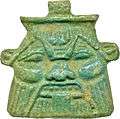Bes
| Bes | |
|---|---|
| God of newborn babies, family, pregnant women | |
 Bes statue from Amanthus (Cyprus) in the Istanbul Archaeological Museums | |
| Major cult center | New Kingdom |
| Symbol | Ostrich feather |
| Consort | Beset |
Bes (/bɛs/; also spelled as Bisu) is an Ancient Egyptian deity worshipped as a protector of households, and in particular, of mothers and children and childbirth. Bes later came to be regarded as the defender of everything good and the enemy of all that is bad. While past studies identified Bes as a Middle Kingdom import from Nubia, more recent research indicates that he was present in Egypt since the start of Old Kingdom. Mentions of Bes can be traced to pre-dynastic Nile Valley cultures; however his cult did not become widespread until the beginning of the New Kingdom.
| Part of the myth series on |
| Religions of the ancient Near East |
|---|
| Pre-Islamic Arabian deities |
|

Iconography
Modern scholars such as James Romano claim that in its earliest inception Bes was a representation of a lion rearing up on its hind legs.[1] After the Third Intermediate Period, Bes is often seen as just the head or the face, often worn as amulets.
Worship
Images of the deity were kept in homes and he was depicted quite differently from the other gods. Normally Egyptian gods were shown in profile, but instead Bes appeared in portrait, ithyphallic, and sometimes in a soldier's tunic, so as to appear ready to launch an attack on any approaching evil. He scared away demons from houses, so his statue was put up as a protector.
Bes was a household protector, throughout ancient Egyptian history becoming responsible for such varied tasks as killing snakes, fighting off evil spirits, watching after children, and aiding (by fighting off evil spirits) women in labour (and thus present with Taweret at births).
Since he drove off evil, Bes also came to symbolize the good things in life - music, dance, and sexual pleasure. Later, in the Ptolemaic period of Egyptian history, chambers were constructed, painted with images of Bes and his wife Beset, thought by Egyptologists to have been for the purpose of curing fertility problems or general healing rituals.
Many instances of Bes masks and costumes from the New Kingdom and later have been uncovered. These show considerable wear, thought to be too great for occasional use at festivals, and are therefore thought to have been used by professional performers, or given out for rent.
In the New Kingdom, tattoos of Bes could be found on the thighs of dancers, musicians and servant girls.
Like many Egyptian gods, the worship of Bes was exported overseas, and he, in particular, proved popular with the Phoenicians and the ancient Cypriots. In the late 500s BC, images of Bes began to spread across the Persian Empire, which Egypt belonged to at the time. Images of Bes have been found at the Persian capital of Susa, and as far away as central Asia. Over time, the image of Bes became more Persian in style, as he was depicted wearing Persian clothes and headdress.
The Balearic island of Ibiza derives its actual name from this god, brought along with the first Phoenician settlers 654 BC. These settlers, amazed at the lack of any sort of venomous creatures on the island thought it to be the island of Bes (<איבשם> ʔybšm *ʔibošim). Later Romans called it Ebusus.
-

Mask depicting Bes, early 4th-1st century BC. The Walters Art Museum.
Popular culture
- Bes is an important character in the books of the saga The Kane Chronicles by Rick Riordan.
- Bes appears, as part of the delegation of Egyptian gods, in The Sandman: Season of Mists, by Neil Gaiman.
See also
Bibliography
| Wikimedia Commons has media related to Bes. |
- The Complete Gods and Goddesses of Ancient Egypt, Richard H. Wilkinson. ISBN 0-500-05120-8
- The Oxford History of Ancient Egypt, Ian Shaw. ISBN 0192804588
References
- ↑ The Complete Gods and Goddesses of Ancient Egypt, Wilkinson pub. Thames & Hudson, pg.104 ISBN 0-500-05120-8
Further reading
- Dasen, Veronique (2013). Dwarfs in Ancient Egypt and Greece. Oxford: Oxford University Press. ISBN 0-199-68086-8